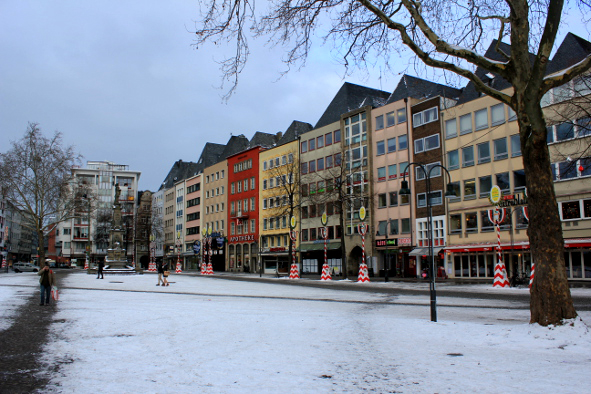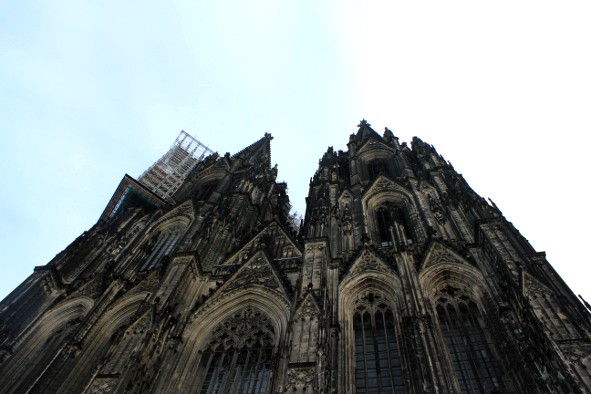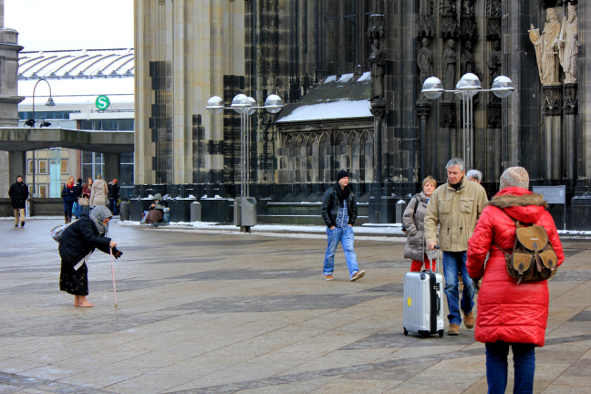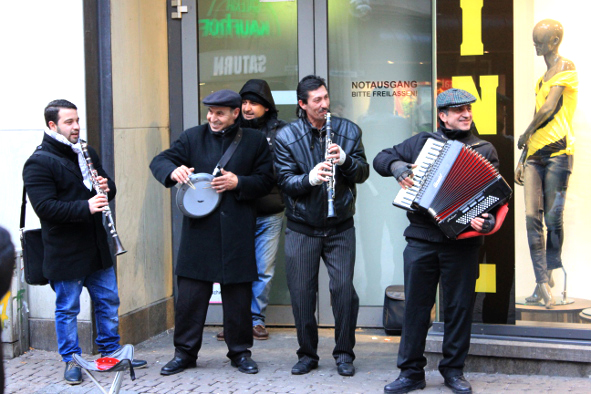Like many German cities, Cologne was more or less leveled during the Allied bombings of World War 2, but the cultural capital of the Rhineland has nonetheless maintained its heritage through the nation’s postwar modernization, preserving and even recreating the historic charms of its Altstadt.

Snow dusts the streets of Cologne (Photo: Jeff Rindskopf)
I visited Cologne in the winter, when a fresh blanket of snow lingered on every surface of the city’s Altstadt. As I strolled through the alleyways of the picturesque old city, I nearly forgot that many of the buildings I passed were inauthentic recreations of past glories destroyed by war.
There’s something to be said for this kind of inauthenticity. Through an incredibly difficult postwar period, Cologne hangs onto its long history instead of sweeping it under the rug in the midst of a massive push towards modernization. The old buildings and alleyways of Cologne, recreated or not, represent a strong commitment to the region’s rich cultural history.
The Dom
Cologne is built around its most conspicuous church—the Dom, or Cologne Cathedral, a towering structure topped by twin spires that loom over the entire city. During the bombings the cathedral survived mostly intact while the rest of the city was turned to rubble. But even the Dom couldn’t survive the war totally unscathed.
I spotted the Cathedral from far off in the city, but the distant view couldn’t prepare me for the experience of looking up at the structure from its base. It makes one feel truly small and humbled: Bronzed columns of stone join and split and reach endlessly upwards toward the twin peaks. Every inch of the cathedral is adorned with intricate carvings, together composing one enormous, masterful work of art.
A scaffolding of metal and tarps partially covered one corner of the Cathedral – a reminder that it takes consistent work to preserve a building that’s survived since its construction began in 1248.
Altstadt Alleyways
From the Cathedral, I rambled through the surrounding downtown area, my feet crunching through patches of untouched snow in modest avenues.
Within walking distance of the cathedral, there are multiple Catholic churches, called the twelve Romanesque churches, all reconstructed on the foundations of the ruined original buildings. Walking into candlelit church after candlelit church, I felt an air of disquieting reverence one never quite feels inside an American church.
Through my American eyes, almost every red-bricked building in the Altstadt looked like an ancient structure rich with history—never mind that 95 percent of the neighborhood had been leveled during World War 2, and the reconstruction only finally completed in the ‘90s.
Modern museums are numerous in this area of Cologne, but the cobblestone alleyways conceal more remote sights, including charming independent shops and canopies of stripped trees standing like islands among a concrete sea. I warmed up in a British used book shop, where a few English folks sipped tea between towering shelves of aged literary classics—a welcome place for a bibliophile looking to get out of the cold.
The alleyways open up into larger pedestrian areas, including the many plazas surrounding the Rathausplatz, home to Germany’s oldest city hall still in use, an impressive building marked by two stories of carved archways culminating in an open-armed statue welcoming visitors.
The Culture
The nearby Alt Markt (old market), a central place of commerce that’s lasted for centuries, was crowded by rows of colorful multi-story restaurants, bars and shops, all topped with pointed roofs.
A few of those shops, I noticed, were far more popular than others, including the ever-crowded international clothing shops of the bustling Hohe Strasse shopping district. Locals were lining up in droves to buy vibrant, even gaudy clothes for the upcoming “crazy days” of their annual Carnival celebration. For so many people waiting patiently in the cold, the long-standing cultural festival took precedence over the trendy shops just a few blocks away.
There’s evidence of the culture Cologne worked so hard to maintain all throughout the city, in fact. Even beside American-inspired steakhouses and delicious Italian gelato shops, traditional beer halls brimming with joyous groups of family and friends serve slabs of pork knuckle with potato side dishes and glass mugs of the region’s signature beer Kölsch.
The lively atmosphere continued in the cold outdoors, as well—a colorful accordion and woodwind-based band attracted a large crowd, as the clarinet player blared his instrument in the face of a man trying to speak on his cellphone. Not far off, a group of politically-aware Cologne residents marched along the cobblestones, chanting for “Freiheit für Syrien” (freedom for Syria).
In the shadow of the interlocking steel of the Hohenzollern Bridge that connects the two halves of Cologne, I walked along the Duffesbach, beside the Rhine River which gives life to the entire region. Beyond the barren trees beside me, the river flowed unceasingly onward, cruise ships ferrying across its cool waves.
I turned to face the city. Far from being trapped in the past, the Cologne skyline includes the needle-like Colonius TV tower and the glass-windowed, L-shaped Kranhaus buildings.
Despite these signs of successful modernization, I was most impressed by the old world architecture I could see from here, and the corresponding culture Cologne has done so well to preserve despite its difficult recent history. It’s fascinating and intoxicating to see a city that’s managed so well to achieve a respectful dichotomy of the new and the old, the past and the future, the Cathedral and the TV tower.


